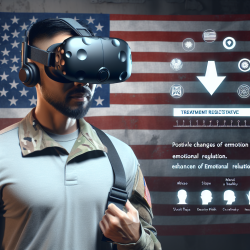Introduction
In the realm of mental health, particularly concerning treatment-resistant posttraumatic stress disorder (TR-PTSD), innovative therapeutic approaches are essential. The study titled "Decreased Emotional Dysregulation Following Multi-Modal Motion-Assisted Memory Desensitization and Reconsolidation Therapy (3MDR): Identifying Possible Driving Factors in Remediation of Treatment-Resistant PTSD" explores a novel intervention that combines virtual reality with traditional therapeutic techniques. This blog delves into the findings of this study and discusses how practitioners can leverage these insights to enhance their therapeutic practices.
Understanding 3MDR
3MDR is an interactive, virtual reality-assisted therapy designed for individuals with TR-PTSD, particularly military members and veterans. It integrates elements of eye movement desensitization and reprocessing (EMDR), virtual reality exposure therapy, and trauma-focused cognitive behavioral therapy (CBT). The therapy involves patients walking on a treadmill while engaging with traumatic images and music, facilitating emotional processing and memory reconsolidation.
Key Findings
The study conducted a mixed-methods analysis, combining quantitative data from the Difficulties in Emotional Regulation Scale (DERS-18) with qualitative insights from participant interviews. The results indicated statistically significant improvements in emotional regulation (ER) post-intervention, with decreases in DERS-18 scores observed at one week, one month, and three months following the therapy.
- Statistically significant decreases in emotional dysregulation scores were observed at all post-intervention time points.
- Participants reported enhanced emotional awareness, clarity, and the ability to employ effective coping strategies.
Implications for Practitioners
For practitioners, these findings underscore the potential of 3MDR as a viable intervention for TR-PTSD. By incorporating cognitive-motor stimulation and eye movement bilateral stimulation, 3MDR addresses emotional dysregulation through a comprehensive, multi-modal approach. Practitioners are encouraged to consider the following strategies:
- Integration of Virtual Reality: Utilize virtual reality to create immersive therapeutic environments that facilitate emotional processing.
- Focus on Emotional Regulation: Incorporate techniques that enhance emotional awareness and clarity, helping patients develop effective coping mechanisms.
- Encourage Further Research: Engage in or support research efforts to explore the neurobiological mechanisms underlying 3MDR's efficacy.
Future Directions
The promising results of this study highlight the need for further research to understand the neurobiological mechanisms at play. Implementing neuroimaging techniques and expanding the participant pool could provide deeper insights into the long-term effects of 3MDR on emotional regulation. Practitioners are encouraged to stay informed about ongoing research and consider participating in studies to contribute to the growing body of evidence supporting 3MDR.
To read the original research paper, please follow this link: Decreased Emotional Dysregulation Following Multi-Modal Motion-Assisted Memory Desensitization and Reconsolidation Therapy (3MDR): Identifying Possible Driving Factors in Remediation of Treatment-Resistant PTSD.










